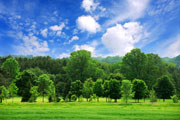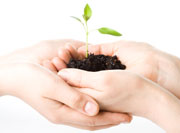
Q. What one sentence describes my idea?
A. A reforestation program in Sri Lanka, involving the planting of 40,000 trees, aimed to better the environment and to improve the lives of those still affected by the 2004 Tsunami.
Q. My idea in more depth.
A. On December 26th 2004 I was sleeping on the beach of Unawatuna, Sri Lanka when the Tsunami hit. I miraculously managed to survive the fury of the wave, after being trapped, submerged and almost drowned, but it was only thanks to the generosity and selflessness of the people of Sri Lanka that I, and all displaced tourists, managed to return home safely. Surviving this catastrophe of incalculable proportions, I feel like I have received an enormous gift but also a great responsibility. The 40,000 TREES Project is a reforestation program and also a site-specific art performance in Sri Lanka where I will be planting 40,000 trees around the coasts of the island. The trees represent a memorial in remembrance of the 40,000 lives lost in this tragedy and a tribute to those who so lovingly helped us. The planting of the seedlings will create temporary job positions and biodiversity with Forest Garden ecosystems which will generate sustainable income for local communities. The trees will produce food, fuel-wood, shelter, forage, organic fertilizers, bio-diesel and other marketable by-products. Some plants have medicinal properties and produce leaves containing essential vitamins particularly suitable for children: I hope to bring them some hope for a brighter, greener future. Trees systems restore soils and remove Carbon from the atmosphere, contributing to cooling the Earth. An important part of this project is training communities to take good care of these plants, which will create a natural barrier against future manifestations of Nature. I will document the entire process step-by-step on a multimedia Blog. After being planted, the trees will appear on Google Earth with precise coordinates and donors' names. I see trees as hope, rebirth and "re-leaf" and that's exactly what Sri Lanka needs. Right now.
Q. What problems or issues does this project address?
A. This project addresses multiple urgent issues: civil war, poverty, unemployment, low agricultural production, energy, global warming, the long-term lasting effects of natural disasters and the need for a continuing relief effort. Planting multipurpose fast-growing trees together with indigenous plants in all areas of Sri Lanka will promote peace at a very unstable political time. It will temporarily create jobs for local communities, fighting the unemployment that worsened terribly after the Tsunami, while giving families new sustainable forms of income. Forest Garden systems highly improve agricultural production by creating biodiversity and by introducing new agroforestry techniques which better manage fields and maximize harvests. Planting trees directly addresses energy issues by producing sustainable charcoal, fuel-wood and ultimately bio-fuels. These 40,000 trees will contribute to the fight against global warming by purifying the atmosphere, and against erosion and flooding by creating a natural barrier to protect this beautiful Country and its wonderful people.
Q. If this idea were to become a reality, who would benefit the most and how?
A. This idea was born with people in mind and people will be at the forefront of this project all throughout its course. New land use systems that maximize production while improving soil quality and conserving water resources ought to reach those who need them the most. This project would bring sustainable income and food security to local Sri Lankan communities and families. Children would highly benefit form this mission as the trees will grow with them and will provide them with food, shelter and necessary vitamins. Integrating the production of bio-fuels would bring far greater benefit to all participating families and to our environment by reducing carbon emissions while also removing carbon from the atmosphere. Ultimately, we would all globally benefit from planting 40,000 trees and, since Sri Lanka enjoys a tropical climate, the trees would grow even faster subtracting as much as 1000 tons of carbon dioxide each year.
Q. What are the initial steps required to get this idea off the ground?
A. The steps that were addressed include the completion of an extensive agroforestry training, building a website, collecting worldwide contacts and learning from non-profit organizations specialized in planting trees. The very first challenge to overcome now is finding the budget to sustain this extremely feasible project. Secondly, I plan on traveling to Sri Lanka as early as December 2008 to launch this project on the 4th anniversary of the Tsunami. This fact-finding trip is necessary to network with families, local communities who are going to participate, Buddhist monks and government officials like the Minister of Agricultural and Agrarian Services Development, and to identify and create local nurseries that will cultivate the seedlings to be transplanted. This journey will allow me to train and motivate people to establish a solid foundation for a sustainable program, and to structure a complete roadmap of all steps required to bring this project to fruition.
Q. Here is a description of the optimal outcomes, should this idea be successfully implemented. How would I measure it?
A. The first optimal outcome of The 40,000 TREES Project would be the survival and productivity of the trees. If properly trained, local Sri Lankan communities involved in the planting and maintenance of the trees would know how to protect and harvest these plants, which will allow them to provide for themselves and generate sustainable and marketable products. An increase in local agricultural productivity would be a proof that this project has reached its intended goals. This venture also includes follow-ups that will give local communities the opportunity to share how this project has affected them, what could be improved and which benefits they have obtained from it. The most suitable outcome would be that the 40,000 trees would have contributed to saving our planet and would have improved both local and global environments, preparing a greener, less polluted future for our children and for the children of Sri Lanka.




